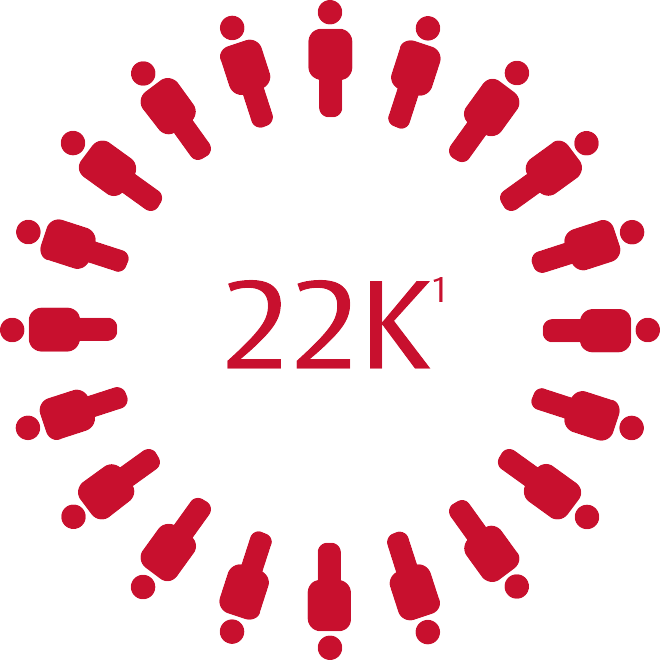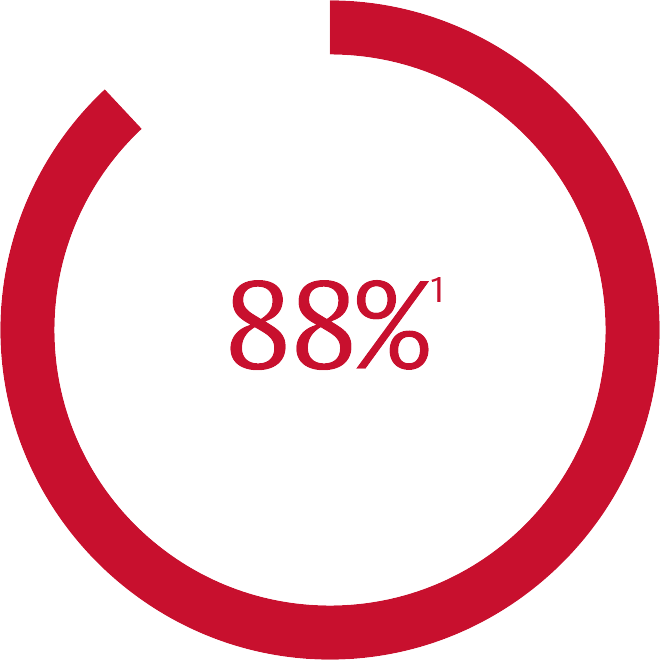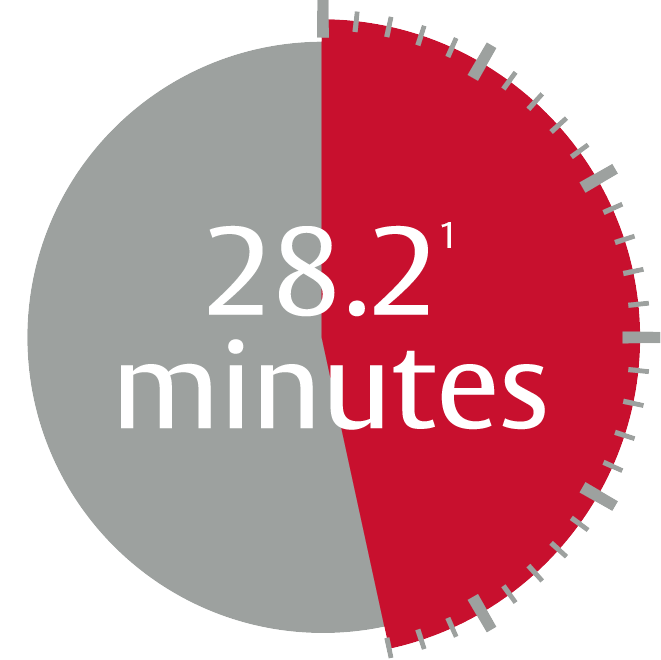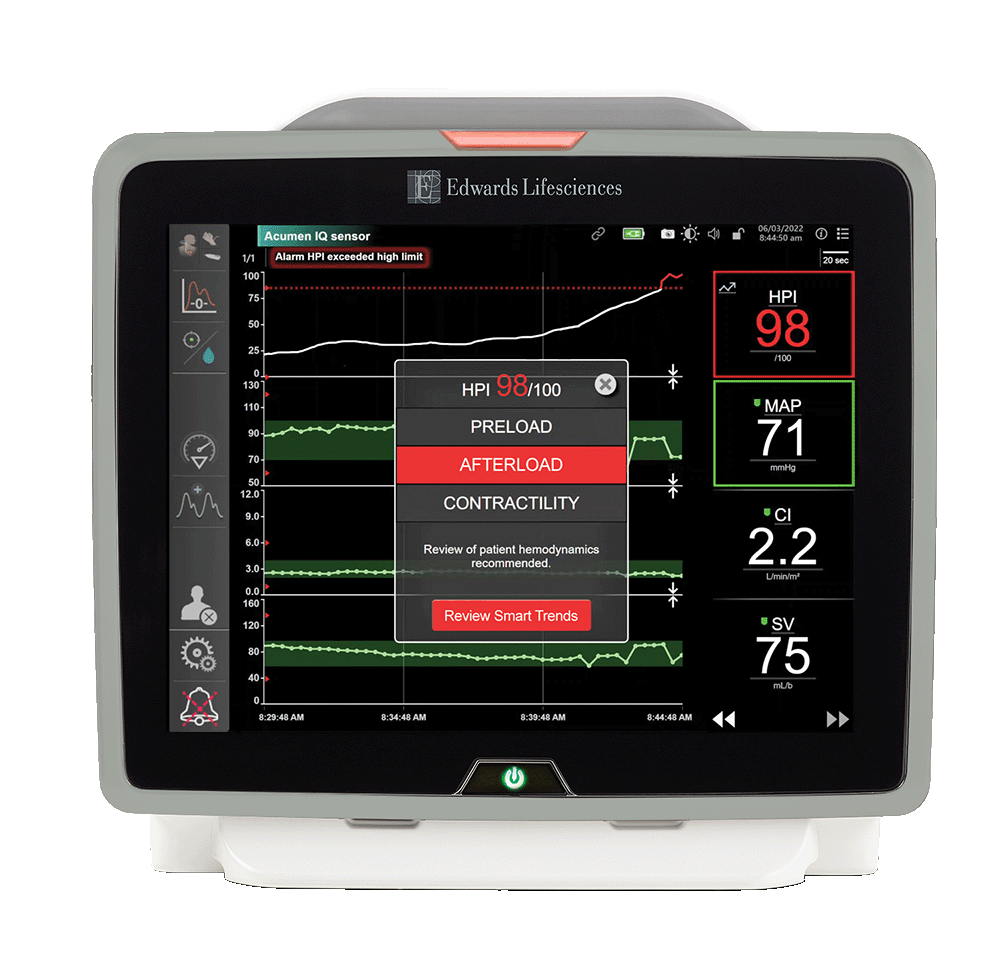88% of patients† experienced intraoperative hypotension (IOH)^ during non-cardiac surgery*1

Study included over 22,000 non‑cardiac surgery patients1

Demonstrated 88%^ of cases had at least one hypotensive event1

Mean cumulative duration of IOH* was 28.2 minutes (standard deviation 42.6 minutes)*1
*From a retrospective multicentre observational study that evaluated moderate-to-high risk (ASA status of 3 or 4) noncardiac surgery patients monitored for hypotension at hospitals that used an invasive arterial line ≥75% of the time.
^Hypotension/hypotensive event was defined as MAP < 65mmHg for at least one minute¹
† 19,446 /22,109 noncardiac surgery patients.¹
Numerous studies show IOH is strongly associated with risk, especially3,4,6-11:

Acute kidney injury

Myocardial injury

Mortality
Find out what can be
done to predict IOH12
Acumen Hypotension Prediction Index software
A first-of-its-kind intelligent decision support suite that provides clinicians with information regarding the likelihood of a patient trending toward a hypotensive event*, allowing proactive treatment.12,13
*A hypotensive event is defined as mean arterial pressure < 65 mmHg for at least one minute in duration.

Acumen HPI software has demonstrated a reduction* in the duration of IOH by 57%.
*A single arm, multicenter, prospective-to-historical control where noncardiac surgical patients received arterial line monitoring.
Predict hypotension sooner.* Act ahead of time.14,15

Want to see the data?
Request your summary of key validation studies and see the data for yourself.
Enter your contact details
heading 3
Content goes here
*In a two-center retrospective analysis of patients undergoing major surgery, the Hypotension Prediction Index software demonstrated superior predictive ability than the commonly measured perioperative haemodynamic variables. Predictive performance of HPI is superior to that of CO, SV, MAP, PP, HR, SVV and Shock Index.15
References:
- Shah NJ, Mentz G, Kheterpal S. The incidence of intraoperative hypotension in moderate to high risk patients undergoing non-cardiac surgery: A retrospective multicenter observational analysis. J Clin Anesth. 2020 Nov;66:109961.
- Salmasi, V., Maheshwari, K., Yang, G., Mascha, E.J., Singh, A., Sessler, D.I., & Kurz, A. (2017). Relationship between intraoperative hypotension, defined by either reduction from baseline or absolute thresholds, and acute kidney injury and myocardial injury after noncardiac surgery: A retrospective cohort analysis. Anesthesiology, 126(1), 47-65.
- Sun LY, Wijeysundera DN, Tait GA, Beattie WS. Association of intraoperative hypotension with acute kidney injury after elective noncardiac surgery. Anesthesiology. 2015 Sep;123(3):515- 23.
- Walsh M, Devereaux PJ, Garg AX, Kurz A, Turan A, Rodseth RN, Cywinski J, Thabane L, Sessler DI. Relationship between intraoperative mean arterial pressure and clinical outcomes after noncardiac surgery: toward an empirical definition of hypotension. Anesthesiology. 2013 Sep;119(3):507-15.
- Sessler DI, Khanna AK. Perioperative myocardial injury and the contribution of hypotension. Intensive Care Med. 2018 Jun;44(6):811-822. doi: 10.1007/s00134-018-5224-7. Epub 2018 Jun 4. PMID: 29868971.
- Gregory A, Stapelfeldt WH, Khanna AK, et al. Intraoperative hypotension is associated with adverse clinical outcomes after noncardiac surgery. Anesth Analg. 2021;132(6):1654-1665.
- Wesselink EM, Kappen TH, Torn HM, et al. Intraoperative hypotension and the risk of postoperative adverse outcomes: a systematic review. Br J Anaesth. 2018;121(4):706-721.
- Monk TG, et al. Anesthetic Management and One-Year Mortality After Noncardiac Surgery. Anesth Analg 2005;100:4–10.
- Monk TG, et al. Association between Intraoperative Hypotension and Hypertension and 30- day Postoperative Mortality in Noncardiac Surgery. Anesthesiology 2015; 123:307-19.
- Hirsch J, et al. Impact of intraoperative hypotension and blood pressure fluctuations on early postoperative delirium after noncardiac surgery. British Journal of Anaesthesia, 2015:418–26.
- Bijker JB, et al. Intraoperative Hypotension and Perioperative Ischemic Stroke after General Surgery: A Nested Casecontrol Study. Anesthesiology, 2012;116: 658-664.
- Ward H. van der Ven, Denise P. Veelo, Marije Wijnberge, Björn J.P. van der Ster, Alexander P.J. Vlaar, Bart F. Geerts, One of the first validations of an artificial intelligence algorithm for clinical use: The impact on intraoperative hypotension prediction and clinical decision-making, Surgery, Volume 169, Issue 6, 2021, Pages 1300-1303, ISSN 0039-6060, https://doi.org/10.1016/j.surg.2020.09.041.
- Feras Hatib, Zhongping Jian, Sai Buddi, Christine Lee, Jos Settels, Karen Sibert, Joseph Rinehart, Maxime Cannesson; Machine-learning Algorithm to Predict Hypotension Based on Highfidelity Arterial Pressure Waveform Analysis. Anesthesiology 2018; 129:663–674 doi: https://doi.org/10.1097/ALN.0000000000002300.
- Hatib F et al, Machine-learning Algorithm to Predict Hypotension Based on High-fidelity Arterial Pressure Waveform Analysis Anesthesiology 2018, Vol.129, 663-674.
- Davies SJ, Vistisen ST, Jian Z, Hatib F, Scheeren TWL. Ability of an Arterial Waveform AnalysisDerived Hypotension Prediction Index to Predict Future Hypotensive Events in Surgical Patients. Anesth Analg. 2020 Feb;130(2):352-359.
Medical device for professional use.
For a listing of indications, contraindications, precautions, warnings, and potential adverse events, please refer to the Instructions for Use (consult eifu.edwards.com where applicable).

